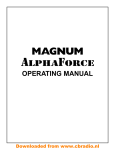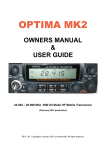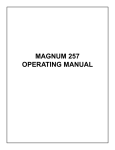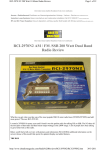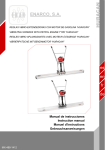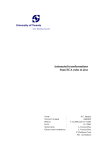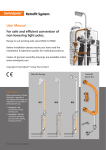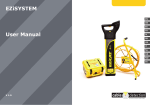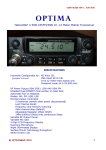Download Yeti Communications Huracan HR-07-NZ Specifications
Transcript
Downloaded from www.cbradio.nl CONGRATULATIONS on your purchase of a HURACAN HR-07-NZ 10meter amateur radio. Your HURACAN HR-07-NZ transceiver radio is designed to provide trouble-free service and state of the art, high performance SSB communications. This radio has been designed with the SSB eenthusiast in mind incorporating new circuitry for increased SSB stability and improved SSB audio. To ensure proper performance, please read this manual thoroughly. BEFORE YOU OPERATE THE HR-07-NZ 10 METER AMATEUR RADIO In most countries a special licence is required to transmit on Amateur radio frequencies. Please ensure you have the required licence to operate this radio in the country you are using it. YeticomNZ is not responsible for any liabilities resulting from improper or unlicenced use of this equipment. SPECIFICATIONS: HR-07-NZ 10 METER HF MOBILE TRANSCEIVER GENERAL Frequency Range: Frequency Control: Frequency Tolerance: Frequency Stability: Operating Temp. Microphone: Input Voltage: Current Drain: Tx : Rx : Size: Weight: Antenna Connector: Meter: 10m Band 28.000-29.995 MHz. Export 25.000-29.995 export (5 bands 1mhz ea) NZ CB 26.330-26.770 40ch CB Band with channel readout Phase Lock Loop (PLL) synthesizer. 0.005% 0.001% Range: -22 F to +122 F. Plug-in dynamic; with push-to-talk switch and coiled cord. 13.8V DC nominal, 15.9V max 11.7V min. AM full mod., 2.2A. Squelched, 0.3A. Maximum AF output, 0.7A 2-3/8 (H) x 7-7/8 (W) x 9-1/4 (D) 5 lbs. UHF, SO239 Illuminated ; indicates relative output power, received signal strength TRANSMITTER Power Output (Max): AM FM SSB 10w Carrier/50W PEP 50W 50W PEP Modulation: AM = Class B Amplitude. FM = 2.5Khz @ 20mV 1Khz Audio in Spurious Emission -60dB AF Modulation Response AM / FM 450 – 2500 Hz RECEIVER Circuit Type : Dual-Conversion Superheterodyne Intermediate Frequencies : 1st IF / SSB IF ........ 10.695 MHz 2nd IF ........................ 455 kHz Sensitivity : SSB ...................................................0.25 μV at 10 dB S + N/N AM ....................................................1.0 μV at 10 dB S + N/N FM.....................................................0.3 μV at 12 dB SINAD Selectivity : SSB .................................4.2 kHz (-6 dB) / 8.5 kHz (-60 dB) AM / FM ........................................... 6.0 kHz (-6 dB) / 18 kHz (-60 dB) IF Frequencies AM/FM 1st 10.695Mhz, 2nd 455Khz.SSB 10.695Mhz Adjacent Channel Rejection : Better than 70 dB IF Rejection : Better than 80 dB for all frequencies Automatic Gain Control (AGC): Less than 10dB change in audio output for inputs From 10 V to 50,000 V. Squelch/ RF Gain Controls: 0.5 V=0dB Center Ref. adjustable +3dB to –40dB From threshold at rated sensitivity adjustable at Full mute 25 V at Max Gain, 1mV at Min. Gain. ANL+NB: RF Type ANL @3dB + NB @12dB Clarifier Range : Fine: 1.5Khz Rx/Tx Audio Output: 4W Max., 3W @10% THD with 8 Ohms Load. Audio Response: 450-2500Hz. External PA Output: 4W at 8 Ohms, disables internal speaker while plugged-in. INSTALLATION 1. Contents Unpack and inspect your Huracan HR-07-NZ for missing or damaged components. Your Huracan HR-07-NZ includes the following items: Quantity Description 1 Huracan HR-07-NZ Transceiver 1 Dynamic Microphone 1 DC Power Cord with Inline Fuse 1 Mounting Bracket with Hardware 1 Mic Hanger with Hardware Set 1 Operating Manual 2. Microphone Hanger The microphone hanger may be attached to the side of the transceiver, or any other convenient location. Locate the mounting holes on the side of the transceiver. Use the provided screws to attach the microphone hanger either vertically or horizontally to the side of the transceiver. 3. Mounting When attaching the Huracan HR-07-NZ mounting bracket to the vehicle, choose a location that will provide easy access to all front panel controls and air circulation to the rear panel. When selecting a mounting location, make sure that there is ample space behind the unit for the cables. Do not pinch, or bend sharply, the power or antenna cables. Do not install the Huracan HR-07-NZ in any compartment that restricts airflow to the air vents under the transceiver or blocks the heat sink and do not install in a location that interferes with the safe operation of the vehicle. Attach the mounting bracket to the vehicle first then mount the Huracan HR-07-NZ to the bracket. If the rear panel is not accessible you may want to attach the power and antenna cable prior to mounting. 4. Electrical Connections The Huracan HR-07-NZ is designed to work on any 12 - 14.1 volt DC, negative ground, source. The condition of a vehicle’s electrical system can affect operation. A low battery, worn generator/alternator, or poor voltage regulator will seriously impair the performance of the transceiver. Any of the above conditions could result in a high level of receiver noise generation or a substantial loss of the transmitter’s RF output. Make sure that all of these components of your vehicle’s electrical system are in good condition prior to installing the transceiver. CAUTION! VOLTAGE EXCEEDING 15 VDC WILL DAMAGE THE RADIO. MEASURE VOLTAGE AT BATTERY TERMINALS, WITH VEHICLE RUNNING, PRIOR TO INSTALLATION! Before making any electrical connections make sure the volume (VOL) control is in the “OFF” position. Connect the positive (+) red wire of the DC power cord to a positive 13.8 volt source at the vehicle fuse block. If connecting to the fuse block, it is recommended that a switched power source is used so that the power to the transceiver is is connected when the vehicle is off. This will eliminate the possibility of the transceiver draining the vehicle’s battery. Connect the negative (-) black wire to a metal part of the vehicle’s frame, or chassis ground. Make sure that this is a good ground connection.The Huracan HR-07NZ power cord may also be connected directly to the battery. Connecting directly to the battery has several benefits, the first of which is to maximize RF output. Secondly, the battery is a very large capacitor and will help eliminate certain types of ambient and vehicle noise. If connecting directly to the vehicle’s battery, additional power cable may be required.On runs of 8 feet or less use 14-gauge stranded wire. Use 12-gauge wire on longer runs. 5. Antenna Connection: The transceiver will operate using any standard 50-ohm ground-plane, vertical, mobile whip, long wire or similar antenna. The antenna should be rated at 50 watts PEP minimum. A standard SO-239 type antenna connector is located on the rear panel of the Huracan HR-07-NZ. Connection is made using a PL-259 and high-grade coaxial cable (RG213, RG58A/U or Mini RG-8 is recommended). A ground-plane antenna provides greater coverage and is recommended for fixed station-to-mobile operation. For point-to-point fixed station operation, a directional beam antenna operates at greater distances even under adverse conditions. A non-directional antenna should be used in a mobile installation; a vertical whip is best suited for this purpose. The base loaded whip antenna normally provides effective communications. For greater range and more reliable operation, a full quarter wave whip may be used. Either of these antennas uses the metal vehicle body as a ground plane.Once the antenna is mounted on the vehicle, route the coaxial cable so that it is not next to any power cables or vehicle cables. Connect the PL-259 to the antenna connector on the rear panel of the Huracan HR-07-NZ. Make sure that the cable does not interfere with the safe operation of the vehicle. treadings should be below 1.5 to 1 across the entire operating band. If at the lower or upper end of the transceiver operating frequency, the VSWR measures more than 1.5 to 1, it is recommended that the antenna be retuned before operating on those frequencies.If you are experiencing unusual VSWR readings check for the following possible problems:) 1: Make sure that the antenna is installed properly and grounded. 2) Check all coaxial cable and connectors for defects and poor routing. 3) If testing a vehicle installation, make sure that all vehicle doors are closed when testing. 4) Do not test near or around large metal objects or buildings. 6. VSWR:(Requires external s.w.r meter) Before use, it is important to determine the antenna system’s VSWR (voltage standing wave ratio). You will need a high quality SWR bridge (meter) to accurately tune your antenna system. First, make sure the SWR bridge is in good working order and is calibrated. To ensure your radio is performing properly the VSWR should never exceed 1.5 to 1. Never transmit on any antenna system where the VSWR exceeds 1.8 to 1.This will stress the output stage and could destroy the RF mosfets; this type of misuse and failure is not covered under warranty. Measure the VSWR at the center of the operating band. Tune the antenna (according to the antenna manufacturer’s tuning instructions) so that the VSWR is as close to 1 to 1 at the center of the operating band. Next, measure the VSWR at the lowest and highest frequency of the transceiver. If the antenna has a wide enough frequency range and band-pass, he VSWR WARNING CONTINUOUS OPERATION OF THIS TRANSMITTER WITH GREATER THAN 4:1 VSWR ANTENNA MISMATCH MAY RESULT IN RF AMPLIFIER DAMAGE. TUNING THE ANTENNA FOR OPTIMUM SWR Since there is a such a wide vanity of base and mobile antennas, this section will strictly concern itself to the various types of mobile adjustable antennas. Because the antenna length is directly related to the channel frequency, it must be tuned to resonate optimally all Frequencies of the transceiver. 28.000mhz requires a longer antenna than 29.700mhz, because it is lower in frequency. Due to the various methods of adjusting antennas for proper SWR we have chosen what we think is the optimum method: A. Antenna with adjustment screws (set screws) 1. Start with the antenna extended and tighten the set screw tightly enough so that the antenna can be lightly tapped with your finger for easy adjustment. 2. Set your transceiver to a mid band frequency. Press PTT (push-to-talk) switch, and tap the antenna shorter. The SWR meter will show a lower reading each time the antenna is tapped. By continuing to shorten the antenna you will notice the SWR reading will reach a lowest point and than start to rising again, this means the optimum tuning being pressed for center operating frequency of your transceiver. B. Antennas which must be cut to length 1. Follow the same procedure as above, but adjust the length by cutting in 1/8 inch increments until a good match is obtained. 2. Be very careful not to cut too much at one time, as once it is cut, it can no longer be lengthened. 3. The whip is easily cut by filing a notch all the way around and breaking the piece off with pliers. TIPS for Antenna Adjustment IF YOU ARE HAVING DIFFICULTIES IN ADJUSTING YOUR ANTENNA CHECK THE FOLLOWING: A. All doors of the vehicle must be closed when adjusting the antenna. B. Make sure the antenna base is grounded. C. Check your coaxial cable routing to make sure it is not pinched when routed into the car. D. Try a different location on your car, keeping in mind the radiation pattern you wish. E. Is the antenna perfectly vertical ? F. Try a different location in your neighborhood. Stay away from large metal objects when adjusting, such as metal telephone or light poles, and fences, etc. ANTENNA A vertically polarized, quarter-wavelength whip antenna provides the most reliable operation and greatest range. Shorter, loaded-type whip antennas are more attractive, compact and adequate for applications where the maximum possible distance is not required.Also, the loaded whips do not present the problems of height imposed by a full quarter wavelength whip. Mobile whip antennas utilize the metal body of the vehicle as a ground plane. When mounted at a corner of the vehicle they are slightly directional, in the direction of the body of the vehicle. For all practical purpose, however, the radiation pattern is nondirectional. The slight directional characteristic will be observed only at extreme distances. A standard antenna connector (type SO 239) is provided on the transceiver for easy connection to the standard PL-259 cable termination.If the transceiver is not mounted on a metal surface, it is necessary to run a separate ground wire from the unit to a good metal electrical ground in the vehicle. When installed in a boat, the transceiver will not operate at maximum efficiency without a ground plate, unless the vessel has a steel hull. Before installing the ransceiver in a boat, consult your dealer for information regarding an adequate grounding system and prevention of electrolysis between fittings in the hull and water. 7. Ignition Noise In certain vehicle installations, electrical noise or interference may be present in the receive audio of the transceiver. Typically the vehicle’s ignition system or more specifically the alternator generates this noise. The Huracan HR-07-NZ is equipped with a noise blanker circuit that is designed to reduce, and in many instances eliminate, this electrical noise. In extreme cases, the noise blanker may not eliminate all the electrical noise. In such cases, an alternator/ ignition noise filter can be used Use of a mobile receiver at low signal levels is limited by the presence of electrical noise.The primary source of noise in automobile installations is from the generator and ignition system in the vehicle. Under most operating conditions, when signal level is adequate, the background noise does not present a serious problem. Even though the transceiver has ANL / NB controls, in some vehicles the ignition interference may be high enough to significantly effect the performance of the radio communications. The electrical noise may come from several sources. Many possibilities exist and variations between vehicles require different solutions to reduce the noise level. NOTE : WHEN EXTREMELY LOW LEVEL SIGNALS ARE BEING RECEIVED, THE TRANSCEIVER MAY BE OPERATED WITH VEHICLE ENGINE TURN OFF. THE UNIT REQUIRES VERY LITTLE CURRENT AND THEREFORE WILL NOT SIGNIFICANTLY DISCHARGE THE VEHICLE BATTERY.ON FRONT PANEL CONTROLS: 1. 2-DIGIT CHANNEL DISPLAY Displays operating channel does not display when in Free-band mode.Will display when in 10 meter mode (see options list) or N.Z auto select mode (see control #7). 2. VFO CONTROL: Rotate clockwise to increase frequency or counter-clockwise to decrease frequency. . 3. 6-DIGIT FREQUENCY COUNTER Displays Receive/Transmit frequency in real time 4. MODE SWITCH: Selects desired operation modes. (PA): Public Address Mode. To operate PA, insert a public address speaker or horn into the PA jack on the rear panel of the transceiver. (FM) Frequency modulation (AM) Amitutre modulation (USB) Upper sideband (LSB) Lower sideband 5:BAND SWITCH: Selects band of operation see options list for frequency ranges 6: S/RF Meter: The meter indicates relative receive signal strength, RF output power, The meter features blue backlighting on receive and red backlighting on transmit. The meter features 2 scales Rx signal in 60dB max., and Tx max. 50W, the lower scale indicates relative signal strength (S units) for received transmissions. The top scale indicates the RF output power of the Huracan HR-07-NZ. O 7. Free-band/NZ40 Selector Auto Selector: When in the “Freeband” position the transceiver will work as per the options chart depending on the option the transceiver is setup for. In N.Z mode the channel display lights up and the radio will default to channel 35 (26.720mhz) which is the New Zealand LSB (lower sideband “call channel” 8. CLARIFIER: Transmit and receive tuning range /+1.5khz 9. MONI: All Mode Talk-back Monitor: All Mode Talk Back. is an independent talk back monitor. The AMT functions in all modes and allows the operator to monitor the transmitted audio of the Huracan HR-07-NZ.To increase the volume of the talk back rotate the control clockwise. To decrease rotate counter-clockwise. To turn off the talk back rotate the control completely counter-clockwise. 10. Echo On/Off-Delay: Echo Delay. Varies the amount of delay, or duration of the echo repetition. Rotate clockwise to increase the amount of delay and counter-clockwise to decrease. 11. R.F Power am/fm only: Variable RF Output Power. The transmitted power of the Huracan HR-07-NZ may be varied from 0 to 50 watts peak in Am/Fm modes. Rotate clockwise to increase RF output power. Rotate counter-clockwise to decrease RF output power .Variable 1-10 watts carrier Am Mode /1-50 watts carrier Fm mode. 12. Microphone Gain. Microphone Gain. Increases or decreases the energy developed in the microphone amplifier circuit.The gain increases as the control is rotated clockwise. 13.Sq/Rf Gain control: Squelch and RF Gain combinded. Used to eliminate background or “white” noise when monitoring strong signals. To properly adjust the squelch circuit,Start rotating the control slowly counter clockwise until the received white noise disappears. Adjusts the receiver sensitivity to both signals and background noise. This affects the distance at which a signal can be detected. Turning the control counterclockwise reduces the receiver sensitivity. This is particularly useful in areas where large volumes of traffic (signals) are present 14.ON/OFF: Turns the radio on and off. Rotate the control clockwise until it clicks to turn off. VOL: Volume. Adjusts the AF gain, or volume of the receive audio. Turn clockwise to increase and counter-clockwise to decrease. 15. Rodger Beep: Activates the end of transmission, or roger beep, tone. When activated a 1 kHz tone will automatically transmit upon release of PTT switch .This notifies contacts that your transmission has ended and you are ready to receive their signal 16. Front Mounted Microphone input: Microphone wiring is as follows: Pin 1 : Ground Pin 2 : Microphone Audio Pin 3 : Transmit Pin 4 : Receive 17. Guard-Band Filter ©: (narrow/wide).I.F Filter an Switchable (narrow/standard) 6 pole I.F Filter with buffer .in normal use the filter switch would be in the out position (standard receive bandwidth) under bad band conditions or splatter from a couple of channels away from a over powered station or close station this can be put in to the depressed position (narrow) to help remove or suppress the offending signal. 18. NB-ANL SWITCH: Noise Blanker and Automatic Noise Limiter. In the NB position, only the noise blanker is ON. In the ANL position the automatic noise limiter are ON. The noise blanker circuit eliminates pulse type interference usually associated with automotive ignition systems . 19.DIM /OFF/BRITE: The 3 stage dimmer control allows you to select the proper illumination level for both the S/RF meter and blue LED displays. In the OFF position disables the frequency counter REAR PANEL DETAILS: 1: 50 ohm antenna input SO239 Socket: 2: DC Power Input (13.8 volts dc) 3. Public Address (PA) Horn Jack A PA horn jack is located on the rear panel of the transceiver. The Huracan HR-07-NZ is designed to accept any standard PA horn for use with two-way transceivers. To operate in PA mode, please refer to the previous instructions. 4. External Speaker Jack An external speaker jack is located on the rear panel of the transceiver. The Huracan HR-07-NZ is designed to accept any standard 8 ohm external speaker for use with two way transceivers. IMPORTANT NOTE FOR USE EXTERNAL SPEAKERR1 The external speaker jack “ EXT. SPK. ” on the rear panel, is used for remote receiver monitoring. The external speaker should have 8 ohms impedance and be able to handle at least 4 watts. When the external speaker is plugged in, the internal speaker is disconnected. IT HAS NO AUDIO OUTPUT FROM THIS JACK, WHILE SELECTED TO P.A.MODE OPERATION. USING YOUR RADIO FOR THE FIRST TIME : PROCEDURE TO RECEIVE 1. Turn unit on by tuning ON / OFF VOLUME control clockwise. 2. Set the VOLUME for a comfortable listening level. 3. Set the MODE switch to the desire mode. 4. Listen to the background noise from the speaker. Turn the SQ/RFG Gain control slowly counter clockwise until the noise JUST disappears (no signal should be present). Leave the control at this setting. The SQL/RF Gain. Is now properly adjusted. The receiver will remain quiet until a signal is actually received Do not advance the control too far, or some of the weaker signals will not be heard. 5. Set the VFO selector and band switchs to the desired frequency. 6. Set the SQ/RF gain control fully clockwise for maximum RF gain if required (defeats squelch In this setting.) 7. Select the desired frequency of transmission. 8. Set the MIC. GAIN control fully clockwise. 9. Set R.F power control to power level required. 10. If the frequency is clear, depress the PTT switch on the mic., and speak in a normal voice. PRESS-TO-TALK MICROPHONE Press the switch and the transmitter is activated, the receiver and transmitter are controlled by the PTT switch on the microphone., release switch to receive. When transmitting, hold the microphone two inches from the mouth and speak clearly in a normal “ voice ALTERANIVE MICROPHONES: The Radio come complete with low impedance (500 ohms) dynamic microphone. For best results, the user should select a low-impedance dynamic type microphone or a transistorized microphone. Transistorized type microphones have a low output impedance characteristic.The microphones must be provided with a four-lead cable. The audio conductor and its shielded lead comprise two of the leads. The fourth lead is for receive control, and the third is for transmit control. The microphone should provide the functions shown in FIG. 1 of the microphone wiring schematic.If the microphone to be used is provided with per-cut leads, they must be received as follows. Cut leads so that they extend 7/16” beyond the plastic insulating jacket of the microphone cable. All leads should be cut to the same length. Strip the ends of each wire 1/8” and tin the exposed wire.Before beginning the actual wiring read carefully, the circuit and wiring information provided with the microphone you select. Use the minimum head required in soldering the connections. Keep the exposed wire lengths to a minimum to avoid shorting when the microphone plug is reassembled. MICROPHONE PLUG REASSEMBLING: 1. Remove the retaining screw. 2. Unscrew the housing from the pin receptacle body. 3. Loosen the two cable clamp retainer screws. 4. Feed the microphone cable though the housing, knurled ring and washer shown in FIG. 3. 5. The wires must now be soldered to the pins as indicated in the FIG. 1, wiring tables. If a vise or clamping tool is available, it should be used to hold the pin receptacle body during the soldering operation, so that both hands are free to perform the soldering. If a vise or clamping tool is not available, the pin receptacle body can beheld in a stationary position by inserting it into the microphone jack of the front panel. The numbers of the pins of the microphone plug are shown in FIG. 2, as viewed from the back of the plug. Before soldering the wire to the pins, per-tin the wire receptacle of each pin of the plug. Be sure that the housing and the knurled ring of FIG. 3 are pushed back onto the microphone cable before starting to solder. If the washer is not captive to the pin receptacle body, make sure that it is placed on the threaded portion of the pin receptacle body before soldering.If the microphone jack is used to hold the pin receptacle during the soldering operation,best results are obtained when the connections to pins 1 and 3 are made first and then the connections to pins 2, 4 and 5. Use a minimum amount of solder and be careful to prevent excessive solder accumulation on pins, which could cause a short between the pin and the microphone plug housing. 6. When all soldering connections to the pins of the microphone plug are complete, push the knurled ring and the housing forward and screw the housing onto the threaded portion of the pin receptacle body. Note the location of the screw clearance hole in the plug housing with respect to the threaded hole in the pin receptacle body.When the housing is completely threaded into the pin receptacle body, a final fraction of a turn either clockwise or counter clockwise may be required to align the screw hole with the threaded hole in the pin receptacle body. When these are aligned, the retaining screw is then screwed into the place to secure the housing to the pin receptacle body 7. The two cable clamp retainer screws should now be tightened to secure the housing to the microphone cord. If the cutting directions have been carefully followed, the cable clamp should secure to the insulating jacket of the microphone cable.Upon completion of the microphone plug wiring, connect and secure the microphone plug in the transceiver. Receiving SSB Signals There are four types of signals presently used for communications in an Amateur band: AM, FM, USB and LSB. When the MODE switch on your unit is placed in the AM position, only standard double sideband and in FM position, only frequency deviation, full carrier signals will be detected. An SSB signal may be recognized while in the AM or FM mode by its characteristic “ Donald Duck “ sound and the inability of the AM or FM detector to produce an intelligible output, the USB and LSB modes will detect upper sideband and lower sideband respectively , and standard AM signals SSB reception differs from standard AM reception in that SSB receiver does not require a carrier or opposite sideband to produce an intelligible signal. A signal-sideband transmitted signal consists only of the upper or the lower sideband and no carrier is transmitted. The elimination of the carrier from the AM signal helps to eliminate the biggest cause of whistles and tones heard on channels which make even moderately strong AM signals unreadable.The reduction in channel space required also helps in the receiver because only half of the noise and interference can be received with 100% of the SSB signal. An SSB signal may be received only when the listening receiver is functioning in the same mode. In other words, an upper sideband signal (USB) may be made intelligible only if the receiver is functioning in the USB position. If the lower sideband (LSB) signal is heard when the receiver is in the USB mode, no amount of tuning will make the signal intelligible. The reason for this may be understood if you consider that when modulation is applied to the transmitter’s microphone in the USB mode, the transmitter’s output frequency is increased whereas in the LSB mode the transmitter’s output frequency is decreased. The result in listening the receiver is that when the MODE switch is in the proper position either USB or LSB. A true reproduction of signal tone of modulation will result, and if the tone is increased in frequency such as a low pitched whistle will caused a high-pitched whistle you will hear the increase in the output tone of the receiver. If the incorrect mode is selected, an increase in tone of a whistle applied to the transmitter will cause a decrease in the resultant tone from the receiver. Thus when a voice is used in place of a whistle or tone, in the proper listening mode the voice will be received correctly whereas in the incorrect mode, the voice will be translated backwards and cannot be made intelligible by the voice lock control. When listening to an AM transmission, a correct sideband is heard in either mode since both upper and lower sideband is received. Once the desired SSB mode has been selected, frequency adjustment may be necessary in order to make the incoming signal intelligible, the CLARIFIER control allows the operator to vary frequency above and below the exact-center frequency of the received signal. If the sound of the incoming signal is high or low pitched, adjust the operation of the CLARIFIER. Consider it as performing the same function as a phonograph speed control. When the speed is set to high, voices will be high-pitched and if set too low, voices will be low-pitched. Also, there is only one correct speed that will make a particular record produce the same sound that was recorded. If the record is played on a turntable that rotated in the wrong direction (opposite sideband) no amount of speed control (CLARIFIER) will produce an intelligible sound. An AM signal received while listening in one of the SSB modes will produce a steady tone (carrier) in addition to the intelligence, unless the SSB receiver tuned to exactly the same frequency by the Clarifier control. For simplicity it is recommended that the AM modes be used to listen to AM signals. OPTIONS LIST Introduction: The HURACAN HR-07-NZ is programmed for the 10 Meter Amateur Band out of the box, and covers a range of 28.000 -29.695 MHz in 5 khz steps standard. The frequency range can be extended for Export Use in 6 Band segments OF 1MHZ each containing 200 Channels (200 X 5KHZ STEPS= 1MHZ). 10 Meter Only Mode: The default setting from the factory covers 8 bands between 28.000 MHz – 29.695 MHz. The jumper setting for this is JP1, JP2, JP3 ,JP4 = all jumpers OFF (N.Z 40 channel auto select mode can be used in this mode) Free-band Mode: This mode is pre-set to 6 Bands (1MHZ each 200x 5khz steps )between 25.000 MHz – 30.995 MHz. The jumper setting for this mode is JP1 = ON , JP2= OFF,JP3 = ON JP4 = OFF. (N.Z 40 channel auto select mode can be used in this mode) Programming Notes: * Replace the Metal Cover on the Channel Board after programming to reduce receiver noise.



















